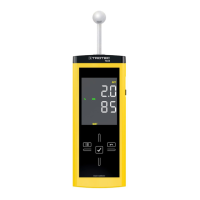EN 9
moisture measuring device T660
Measuring principle
The measurement is effected according to the dielectric
measuring principle.
Notes regarding the measurement principle
• The measurement results are only to be used as reference
for a rough orientation.
• An important variable influencing the measured value is
the bulk density of the good to be measured. The higher
the bulk density, the higher the measured value.
• Before measuring, the measuring point is to be cleared of
any impurities (e.g. paint residues, dust).
• If the material to be measured contains metal (e.g. nails,
screws, lines, pipes, etc.) and is situated within the
sensor's measuring field, the measured value skyrockets.
In that event the measurement is not conclusive.
• When the ball head is held to corners (e.g. window
frames), the measured value is generally higher, because
there is more matter in the measuring head's stray field.
Toward a corner a distance of more than 8 to 10cm has to
be observed.
• During the measurement always hold the measuring
head(6) in a vertical position to the measured material,
press it to the surface and do not tilt it.
• Rough surfaces will always result in a too low measured
value.
• Depending on the material's bulk density, the device's
impact depth amounts to 20 to 40mm. Conclusions
regarding zones located at a lower level cannot be drawn.
• With material thicknesses of less than 20 mm there is a
danger of humidity values from adjacent material layers
affecting the measured value.
• The dielectric measurement method's main area of use
consists in comparative measurements at the same
construction material or similar components. Therefore,
this method is well suited for the examination of water
damage, leak detection and the localization of moisture
zones for the purpose of marking the measuring spot for
CM measurements.
Measured value assessment for wood
The measurement result is either in the dry or the saturated
area.
Saturated means that in addition to the water bound within the
wood there is further liquid. If there is, hence, a measured value
of more than 80, the wood is most like soaked.
Display [digit] Wood moisture zone
< 50 digits dry
> 80 digits limit to the saturated range
Since the measurement value displays of the dielectric
measurement method – depending on marginal conditions – are
subject to great fluctuations, a resistance measurement is
always preferable, in particular for the determination of wood
moisture.

